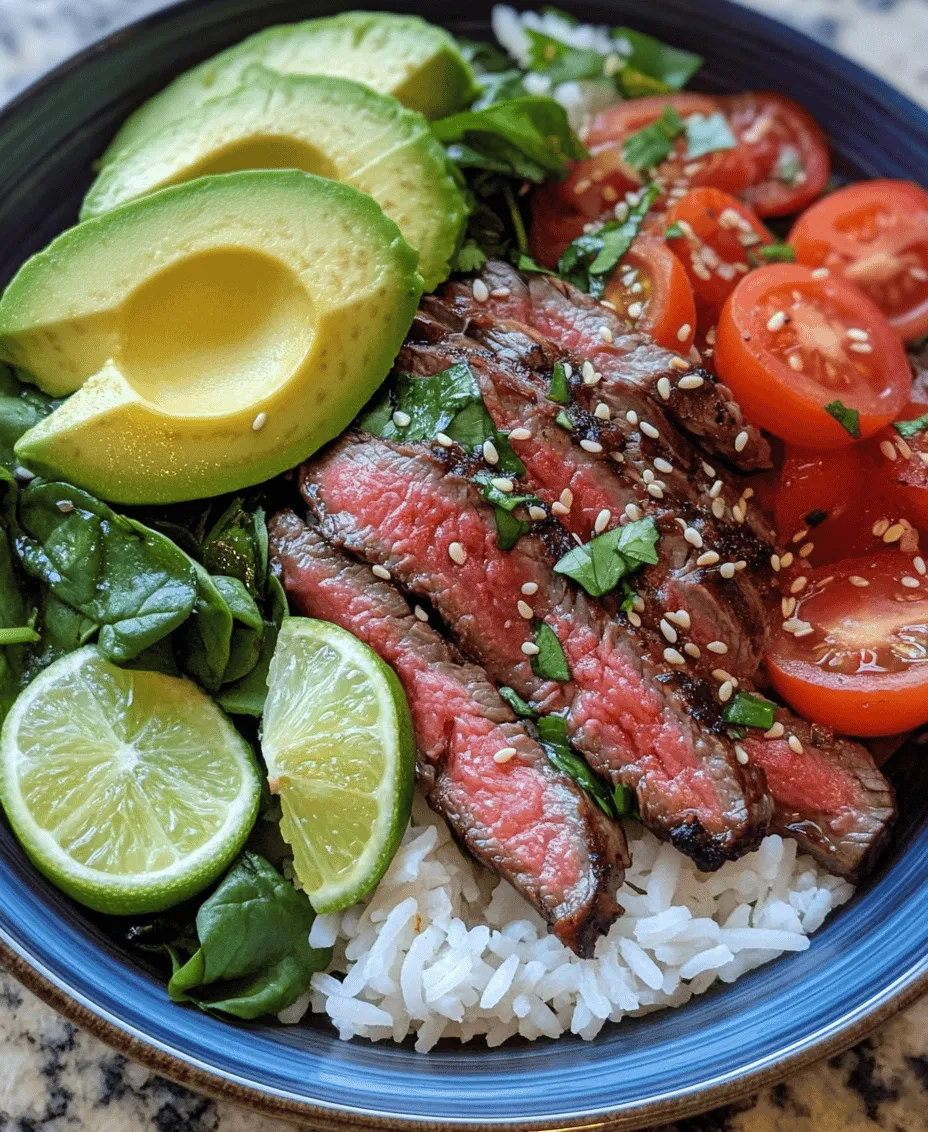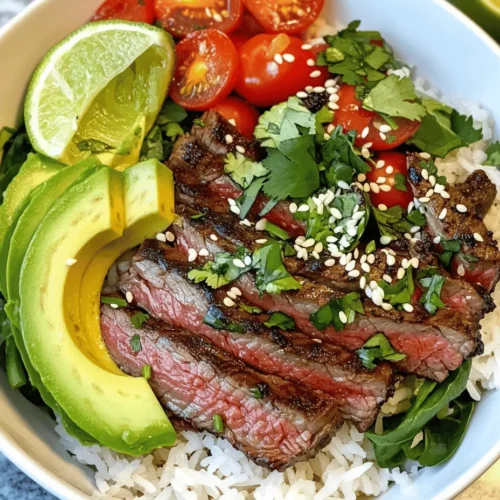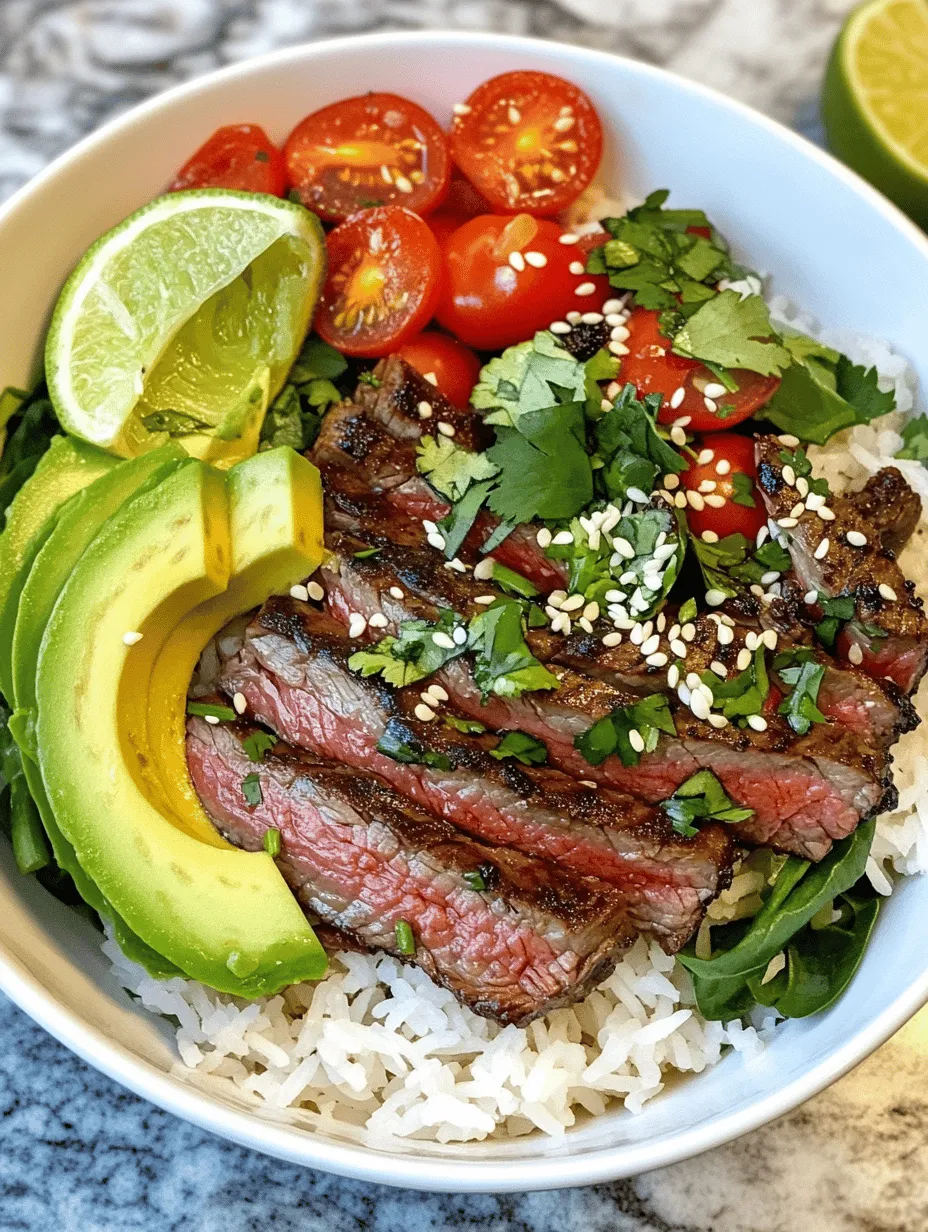Introduction to the Ultimate Steak Bowl
In the realm of comfort food, few dishes can rival the satisfaction of a well-prepared steak bowl. This Ultimate Steak Bowl recipe transcends the ordinary, offering a delightful combination of flavors, textures, and colors that cater to any occasion. Whether you’re planning a casual family dinner, a festive gathering with friends, or meal prepping for the week, this dish is designed to impress. Featuring tender marinated steak, vibrant vegetables, and a base of fluffy jasmine rice, this bowl is not just a meal; it’s an experience.
The allure of steak bowls lies in their versatility. You can customize them to suit your taste preferences, dietary needs, or even the season. Whether you prefer a classic combination of flavors or want to experiment with exciting new ingredients, this recipe serves as an excellent foundation. In this article, we will explore every aspect of crafting the perfect steak bowl, from ingredient selection to cooking techniques, ensuring you have all the information needed to create this culinary masterpiece.
Understanding the Ingredients
The Star of the Bowl: Flank Steak or Sirloin
At the heart of any great steak bowl is, of course, the steak itself. The two most popular cuts for this dish are flank steak and sirloin. Both cuts offer unique qualities that make them ideal for marinating and cooking.
Flank Steak is known for its rich flavor and fibrous texture. This cut comes from the abdominal muscles of the cow, which makes it leaner than other cuts. When properly marinated and cooked, flank steak becomes incredibly tender and packed with flavor. It’s particularly well-suited for quick cooking methods like grilling or broiling, making it an excellent choice for busy weeknights.
Sirloin, on the other hand, is a more versatile cut that offers a good balance between flavor and tenderness. It comes from the back of the cow and is generally more tender than flank steak, making it a popular choice for steak bowls. Sirloin can be cooked to various levels of doneness, allowing you to tailor it to your preferences.
When selecting your steak, look for cuts with a deep red color and good marbling, which indicates fat content. This marbling is essential for flavor and tenderness. If you’re unsure, don’t hesitate to ask your butcher for recommendations based on your cooking plans.
The Base: Jasmine Rice or Quinoa
Next up is the base of your steak bowl, and here you have two fantastic options: jasmine rice or quinoa. Each offers its own set of nutritional benefits and cooking methods.
Jasmine Rice is a long-grain variety known for its fragrant aroma and slightly sticky texture when cooked. It’s a staple in many Asian dishes and pairs beautifully with the flavors of the steak and vegetables. Jasmine rice is an excellent source of carbohydrates, providing energy for your day.
To cook jasmine rice, rinse it under cold water to remove excess starch, then combine it with water in a pot. A general rule of thumb is to use a 1:1.5 rice-to-water ratio. Bring it to a boil, then reduce to a simmer and cover until the rice is tender and the water is absorbed, about 15-20 minutes.
Quinoa, on the other hand, is a nutrient-dense grain that has gained popularity as a healthy alternative to traditional grains. It is high in protein, gluten-free, and rich in fiber, making it an excellent choice for vegetarians and those looking to increase their protein intake. Quinoa has a nutty flavor and a slight crunch, adding a different texture to your steak bowl.
To prepare quinoa, rinse it under cold water before cooking. Use a 1:2 quinoa-to-water ratio, bring it to a boil, then simmer for about 15 minutes until the quinoa is fluffy and the germ separates from the seed.
Depending on your dietary needs or preferences, you can easily customize the base of your steak bowl. For example, if you’re looking for a low-carb option, consider spiralized vegetables or cauliflower rice as a substitute for grains.
Color and Crunch: Mixed Bell Peppers
No bowl is complete without colorful vegetables, and mixed bell peppers are a fantastic choice for adding both color and crunch. Bell peppers are not only visually appealing but also packed with essential nutrients.
These vibrant vegetables are an excellent source of vitamins A and C, as well as antioxidants that help support overall health. When selecting bell peppers, consider using a mix of colors—red, yellow, and green—to create a visually stunning dish. Each color offers slightly different flavors: red peppers tend to be sweeter, while green peppers have a more earthy taste.
If you’re looking for alternatives to bell peppers, consider using other crunchy vegetables like cucumbers, shredded carrots, or snap peas. Each of these options can add a refreshing crunch and unique flavor to your steak bowl.
Fresh Greens: Spinach or Arugula
Adding fresh greens to your steak bowl not only enhances the nutritional value but also provides a refreshing contrast to the richness of the steak. Two popular options are spinach and arugula.
Spinach is a leafy green vegetable that is rich in iron, vitamins A and C, and antioxidants. It has a mild flavor that pairs well with a variety of dishes, making it a versatile addition to your bowl. You can use fresh spinach leaves, or if you prefer, sauté them briefly to wilt them before adding them to the bowl.
Arugula, on the other hand, has a peppery flavor that adds a unique twist to your steak bowl. It is also packed with vitamins and minerals, including calcium and potassium. If you’re looking to spice things up, arugula is a fantastic choice, but keep in mind that its flavor is more pronounced than that of spinach.
If you want to switch things up, consider using other leafy greens such as kale, collard greens, or even mixed salad greens. Each option will bring a different flavor and texture to your dish.
Creamy Addition: Avocado
One of the most beloved and versatile toppings for a steak bowl is avocado. This creamy fruit is not only delicious but also offers a wealth of nutritional benefits. Avocado is rich in healthy fats, particularly monounsaturated fat, which is known to support heart health. Additionally, it provides fiber, vitamins E and K, and potassium.
When selecting avocados, look for ones that yield slightly when pressed gently. This indicates ripeness. If you find a hard avocado, you can speed up the ripening process by placing it in a brown paper bag for a couple of days.
While avocado is a fantastic addition to your steak bowl, there are alternatives if you’re looking for creaminess. Consider using Greek yogurt, sour cream, or a drizzle of tahini for a similar effect.
Flavor Enhancers: Soy Sauce, Sesame Oil, and Seasonings
To elevate the flavors in your Ultimate Steak Bowl, you’ll need some key flavor enhancers. The combination of soy sauce and sesame oil creates a savory and slightly nutty marinade that complements the steak beautifully.
Soy Sauce is packed with umami flavor, enhancing the overall taste of your dish. It adds saltiness and depth, making it an essential ingredient in Asian-inspired recipes.
Sesame Oil, with its rich, nutty flavor, is another fantastic addition that brings a unique aromatic quality to the marinade. Use toasted sesame oil for an even deeper flavor.
In addition to these key ingredients, seasonings such as garlic powder and onion powder will add layers of flavor to your steak. These spices help to create depth and complexity, making the dish more satisfying. Be sure to balance the seasoning with salt and pepper to enhance the overall taste without overpowering the natural flavors of the ingredients.
Step-by-Step Instructions for Preparation
Marinating the Steak
One of the most critical steps in preparing your Ultimate Steak Bowl is marinating the steak. Marinating not only infuses the meat with flavor but also helps to tenderize it, resulting in a juicy and flavorful final product.
The science behind marinating lies in the acidic components of the marinade, which help to break down the proteins in the meat, making it more tender. The ideal marinating time depends on the cut of meat and the ingredients used. For flank steak, a marinating time of at least 30 minutes is recommended, but for optimal flavor absorption, aim for 2 to 4 hours. If you’re short on time, even a quick 15-minute marinade can enhance the flavor.
For those on a budget or with limited time, consider using a simple marinade of soy sauce, sesame oil, and a dash of garlic powder. This quick mix will still impart great flavor to the meat without requiring hours of prep.
In the next sections of this article, we will delve deeper into the cooking techniques, assembly of the bowl, and tips for making your Ultimate Steak Bowl a standout dish. Stay tuned for the complete guide to creating this delicious meal that is sure to impress at any gathering.

Cooking the Rice
To achieve the perfect base for your Ultimate Steak Bowl, cooking the rice—or quinoa, if you prefer a gluten-free option—correctly is essential. For this recipe, we recommend using jasmine rice for its fragrant aroma and fluffy texture.
Rinsing and Cooking Jasmine Rice
Begin by measuring out 1 cup of jasmine rice. Rinse the rice under cold water in a fine mesh strainer until the water runs clear. This step removes excess starch, resulting in a fluffier end product.
Cooking Methods:
1. Stovetop Method:
– In a medium saucepan, combine the rinsed rice with 1 1/2 cups of water and a pinch of salt.
– Bring the mixture to a boil over medium-high heat.
– Once boiling, reduce the heat to low, cover the pot, and let it simmer for 15 minutes without lifting the lid.
– After 15 minutes, remove the pot from heat and let it sit, covered, for an additional 10 minutes to steam.
2. Rice Cooker:
– Rinse the rice as mentioned above, then add it to the rice cooker with the appropriate amount of water (typically 1 cup rice to 1.5 cups water).
– Close the lid and select the white rice setting. The cooker will automatically turn off when the rice is done.
3. Instant Pot:
– Rinse the rice and add it to the Instant Pot with 1 cup of water and a pinch of salt.
– Seal the lid and cook on high pressure for 4 minutes. Allow for a natural release for 10 minutes before venting any remaining pressure.
Fluffing Techniques for Optimal Texture:
Once the rice is cooked, it’s important to fluff it. Use a fork to gently separate the grains, which will help prevent clumping and give you that perfect light and airy texture.
Sautéing the Vegetables
Vegetables add color, crunch, and nutrients to your steak bowl. Sautéing them correctly will enhance their flavors and maintain a pleasant texture.
Ideal Skillet Techniques
To sauté vegetables, heat a large skillet over medium heat and add a tablespoon of oil (olive oil or sesame oil works well). Allow the oil to heat up before adding your vegetables.
Timing and Ordering of Vegetable Addition
For a mix of bell peppers, broccoli, and snap peas:
1. Start with the bell peppers, as they take longer to soften—about 3-4 minutes.
2. Next, add the broccoli, cooking for another 2-3 minutes.
3. Finally, toss in the snap peas and sauté for an additional 1-2 minutes. This method ensures each vegetable retains its unique texture and flavor.
Seasoning Tips for Enhanced Flavor
Season your vegetables with a pinch of salt and pepper as they cook. For an added flavor boost, incorporate minced garlic or a dash of soy sauce during the last minute of cooking. This will infuse the vegetables with a savory depth that complements the steak beautifully.
Cooking the Steak to Perfection
The star of the Ultimate Steak Bowl is the steak itself. Cooking it to perfection requires attention to detail.
Recommended Cooking Temperatures and Doneness Levels
For a tender and juicy steak, aim for the following internal temperatures:
– Rare: 125°F (51°C)
– Medium Rare: 135°F (57°C)
– Medium: 145°F (63°C)
– Medium Well: 150°F (66°C)
– Well Done: 160°F (71°C)
Use a meat thermometer to ensure accuracy.
Techniques for Achieving a Perfectly Seared Steak
1. Choose the Right Cut: Ribeye, sirloin, or flank steak are great options for this bowl.
2. Bring to Room Temperature: Allow the steak to sit out for about 30 minutes before cooking so it cooks evenly.
3. Preheat the Skillet: Use a cast-iron skillet or heavy-bottomed pan, and heat it until it’s very hot. Add a little oil to prevent sticking.
4. Sear: Place the steak in the skillet and do not move it for 3-5 minutes. This allows for a nice crust to form.
5. Flip and Finish: Flip the steak and cook for an additional 3-5 minutes, depending on your desired doneness.
Importance of Resting the Steak After Cooking
Once cooked, remove the steak from the skillet and let it rest for at least 5 minutes. Resting allows the juices to redistribute throughout the meat, ensuring a tender and juicy bite.
Assembling the Bowl
Presentation is key when assembling your Ultimate Steak Bowl. A well-assembled bowl not only looks appetizing but also enhances the dining experience.
Creative Presentation Tips
Start by placing a generous scoop of the cooked rice or quinoa at the bottom of the bowl. Layer your sautéed vegetables on one side, and slice the rested steak against the grain for tenderness, placing it next to the vegetables.
Layering Techniques for Flavor and Texture Balance
Consider adding a few spoonfuls of fresh avocado or guacamole, a handful of fresh greens like spinach or arugula, and a sprinkle of chopped scallions or cilantro. The contrast of flavors and colors from the different components will make your bowl visually enticing.
Suggestions for Portion Sizes and Serving Styles
For an ideal portion, aim for about 1 cup of rice, 1/2 cup of vegetables, and 4-6 ounces of steak per serving. This balance ensures a satisfying meal without overwhelming the senses.
Garnishing and Serving Suggestions
The Finishing Touch: Garnishes
Garnishes play a crucial role in elevating your dish. A sprinkle of sesame seeds adds a delightful crunch and nutty flavor, while fresh herbs like cilantro or basil provide a refreshing contrast.
Visual Appeal of Garnishes
Use garnishes not just for flavor but for visual appeal as well. A well-placed lime wedge or a dollop of spicy mayo can brighten up the dish and entice your guests.
Ideas for Additional Garnishes or Sauces for a Personalized Touch
Consider drizzling your bowl with a tangy sauce like sriracha or teriyaki for an extra kick. You can also serve it with a side of kimchi or pickled vegetables to add a tangy crunch.
Serving the Ultimate Steak Bowl
Suggested Pairings
To complement your Ultimate Steak Bowl, consider serving it with a light beverage such as iced green tea or a crisp white wine. If you are looking for sides, a simple cucumber salad or miso soup can provide a refreshing contrast to the heartiness of the steak bowl.
Importance of Lime Wedges for Added Zest
Don’t underestimate the power of lime wedges! A squeeze of fresh lime over the assembled bowl can enhance all the flavors and add a burst of freshness that ties everything together.
Tips for Meal Prepping and Storing Leftovers
If you’re making this dish for meal prep, store each component separately in airtight containers. The rice and vegetables can last up to 4 days in the fridge, while the cooked steak should be consumed within 2-3 days. Reheat each component gently to preserve the texture and flavor.
Nutritional Breakdown of the Ultimate Steak Bowl
Analyzing the Nutritional Value
The Ultimate Steak Bowl is not only a feast for the eyes but also a nutritious meal option. Here’s a breakdown of the nutritional content:
– Calories: Approximately 600-800 calories per serving, depending on portion sizes and added ingredients.
– Macronutrients: Typically includes 40-50g of protein, 60-80g of carbohydrates, and 15-25g of fat.
Health Benefits Associated with Key Ingredients
– Steak: A great source of high-quality protein, iron, and B vitamins.
– Vegetables: Packed with vitamins A, C, and K, as well as fiber.
– Rice/Quinoa: Provides complex carbohydrates for sustained energy.
Balancing the Meal for Different Dietary Preferences
For those looking for a low-carb option, swapping rice for cauliflower rice or increasing the vegetable portion can help. For a higher protein meal, consider adding an extra serving of steak or incorporating beans for a vegetarian option.
Conclusion: Enjoying Your Ultimate Steak Bowl
In conclusion, the Ultimate Steak Bowl is more than just a recipe; it’s a canvas for culinary creativity that celebrates fresh ingredients and bold flavors. By understanding each component and adhering to the preparation steps, you can create a dish that is not only delicious but also visually appealing and nutritious. This recipe is versatile enough to suit any occasion, making it a staple in your cooking repertoire. Whether it’s a hearty meal for family or a sophisticated dish for guests, the Ultimate Steak Bowl is sure to satisfy and impress, leaving everyone craving more.



